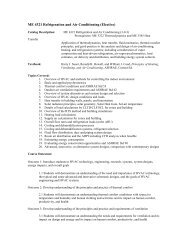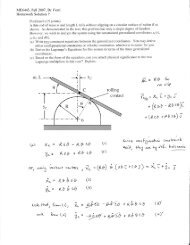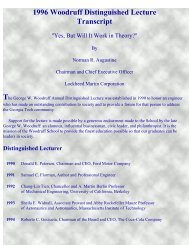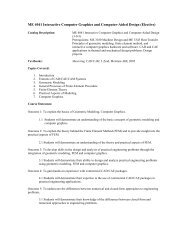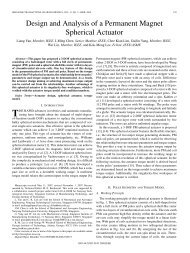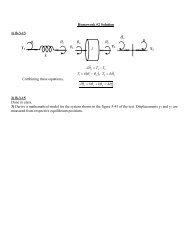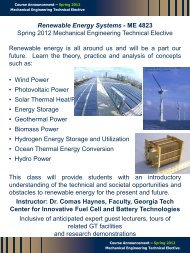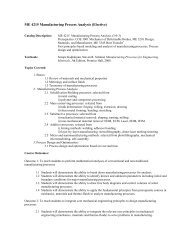Test #1 Solutions - The George W. Woodruff School of Mechanical ...
Test #1 Solutions - The George W. Woodruff School of Mechanical ...
Test #1 Solutions - The George W. Woodruff School of Mechanical ...
Create successful ePaper yourself
Turn your PDF publications into a flip-book with our unique Google optimized e-Paper software.
<strong>George</strong> W. <strong>Woodruff</strong> <strong>School</strong> <strong>of</strong> <strong>Mechanical</strong> Engineering<br />
Georgia Institute <strong>of</strong> Technology<br />
ME2016A <strong>Test</strong> <strong>#1</strong> <strong>Solutions</strong><br />
Summer 2007<br />
NAME __________Key________________<br />
______________________________________________________________________________<br />
Problem 1 2 3 4 Total<br />
Points /15 /15 /15 /15 /60<br />
Please read this first:<br />
1. <strong>The</strong> test is closed-book but you are allowed one 8 1 ×<br />
2 11 sheet <strong>of</strong> notes.<br />
2. <strong>The</strong>re are four (4) problems in this test. Read all <strong>of</strong> the problems carefully and start from the<br />
one that is easiest for you.<br />
3. Budget your time -- total exam time is 1 hour and 45 minutes.<br />
4. Make sure you have a clear presentation for the solutions. No answer without justification is<br />
accepted.<br />
5. Sign the pledge <strong>of</strong> honor below -- any act <strong>of</strong> academic dishonesty may result in your failing<br />
the course.<br />
6. Do not forget to write down your NAME.<br />
I pledge on my honor that the work presented in this test is entirely my own; I have neither<br />
given nor received any inappropriate aid in preparation <strong>of</strong> this test.<br />
Signature ________________________________<br />
STOP HERE<br />
Do not turn the page until further instructions
-2-<br />
ME2016 Quiz <strong>#1</strong><br />
NAME _____________________________<br />
______________________________________________________________________________<br />
Problem 1: A computer stores floating point numbers using 12-bit binary (b=2) words. Of the 10<br />
bits, the first 2 bits are used for the signs <strong>of</strong> the exponent and mantissa, the next 4 bits are used for<br />
the exponent, and the last 6 bits are used for the mantissa as shown below.<br />
s 1 s 2 e 1 e 2 e 3 e 4 d 1 d 2 d 3 d 4 d 5 d 6<br />
a) Convert the following binary floating point number to decimal for all possible values <strong>of</strong> a: (5)<br />
0 1 0 0 1 0 a 0 0 a 0 0<br />
fp number=(ax2 -1 +ax2 -3 )x2 -2<br />
But since a cannot be zero (the 1 st digit <strong>of</strong> the mantissa) it has to be 1. Thus<br />
fp number=(2 -1 +2 -3 )x2 -2 =0.140625<br />
b) What is the largest number (in binary & decimal) that can be stored(4)<br />
binary: 0 0 1 1 1 1 1 1 1 1 1 1<br />
decimal: (0.111111) 2 x2 e , e=(1111) 2 =2 4 -1=15<br />
Largest Number=(1-2 -6 )x2 15 =2 15 -2 9 =32256<br />
c) Fill-in the blanks: Machine epsilon is the largest ___normalized_____round-<strong>of</strong>f error and for<br />
this computer it is equal to 2 -(6-1) =0.03125. (3)<br />
d)What is the final value <strong>of</strong> E in the following script if it is run on this computer (3 pts)<br />
E=1;<br />
while (E+4>4)<br />
E=E/2;<br />
end<br />
E=2*E;<br />
E=4*machine-epsilon=0.125
′′′<br />
-3-<br />
ME2016 Quiz <strong>#1</strong><br />
NAME _____________________________<br />
______________________________________________________________________________<br />
Problem 2: <strong>The</strong> n-th order Taylor series expansion <strong>of</strong> a function f(x) about x i =1 is given by<br />
2 3<br />
n<br />
h h<br />
n h<br />
f ( xi+ 1)<br />
= 1−<br />
h + − + L + ( −1)<br />
+ Rn<br />
2 3<br />
n<br />
n+<br />
1<br />
h<br />
where h=x i+1 -x i is the step-size and the remainder term satisfies Rn ≤ .<br />
n + 1<br />
a) What are the values <strong>of</strong> the function and its first three derivatives at x i (4)<br />
f ( x ) ______1_____, ′(<br />
) _____ 1______, ′′<br />
i<br />
= f xi<br />
= − f ( xi<br />
) = ____1____, f ( xi<br />
) = _____ − 2 _____<br />
General 3 rd Taylor Series:<br />
2<br />
3<br />
h h<br />
f<br />
3(<br />
xi+ 1)<br />
= f ( xi<br />
) + f ′(<br />
xi<br />
) h + f ′′(<br />
xi<br />
) + f ′′′<br />
( xi<br />
)<br />
123 123 123 2 14243 3!<br />
1<br />
−1<br />
1<br />
3<br />
−h<br />
/ 3<br />
b) Approximate f(1.5) based on the third (3 rd ) order Taylor series expansion <strong>of</strong> f . Estimate the<br />
corresponding approximation error (due to truncating the series) (6)<br />
h=1.5-1=0.5.<br />
2 3<br />
0.5 0.5<br />
f<br />
3(1.5)<br />
= 1−<br />
0.5 + − ⇒ f<br />
3<br />
(1.5) = 0. 58333<br />
2 3<br />
n+<br />
1 4<br />
h 0.5<br />
Max Error = Rn ≤ = ⇒ Max Error = 0. 015625<br />
n + 1 4
-4-<br />
ME2016 Quiz <strong>#1</strong><br />
NAME _____________________________<br />
______________________________________________________________________________<br />
c) Write a Matlab function TSA(h,emax) that computes the above Taylor series such that the<br />
resulting approximation error (due to truncating the series) is guaranteed to be less than emax<br />
in absolute value.(5)<br />
function y=TSA(h,emax)<br />
y=1;<br />
er=emax+1;<br />
n=1;<br />
hn=-h;<br />
while(er>emax)<br />
y=y+hn/n;<br />
hn=-hn*h;<br />
er=abs(hn/n);<br />
n=n+1;<br />
end
-5-<br />
ME2016 Quiz <strong>#1</strong><br />
NAME _____________________________<br />
______________________________________________________________________________<br />
Problem 3: We wish to find the root <strong>of</strong> f(x)=4e -x –x+0.2x 2 =0 <strong>of</strong> between 0 and 3 shown below:<br />
4<br />
3<br />
2<br />
f(x)<br />
1<br />
0<br />
x<br />
-1<br />
-2<br />
0 0.5 1 1.5 2 2.5 3<br />
x<br />
a) Use three (3) steps <strong>of</strong> the bisection algorithm to estimate the root <strong>of</strong> f(x)=0.<br />
Approximately how many steps are needed to estimate the root to within 10 -6 <strong>of</strong> the<br />
exact root (5 pts)<br />
Step1: xr=(xl+xu)/2=1.5, f(xr)0⇒xl=xr=0.75<br />
Step3: xr=(xl+xu)/2=1.125<br />
Error≤3(1/2) n =10 -6 ⇒log3-nlog(2)=-6⇒n=22
-6-<br />
ME2016 Quiz <strong>#1</strong><br />
NAME _____________________________<br />
______________________________________________________________________________<br />
b) Use two (2) iterations <strong>of</strong> the Newton-Raphson method to find the root <strong>of</strong> f(x)=0<br />
starting with the initial guesses <strong>of</strong> 0. Illustrate the procedure graphically. (7 pts.)<br />
[Note: de -x /dx=-e -x ]<br />
i x i f(x i ) f’(x i ) x i+1<br />
0 0 4 -5 0.8<br />
1 0.8 1.1253 -2.4773 1.2542<br />
2 1.2542 0.2015 -1.6395 1.3772<br />
Newton iterations:<br />
x i+1 =x i -f(x i )/f’(x i )=x i -[(4e -x –x+0.2x 2 )/(0.4x-1-4e -x )], i=0,1,2,...<br />
c) For what initial guesses does the Newton-Raphson have possible convergence problems<br />
Explain what happens if you start from there graphically. (3 pts.)<br />
For values <strong>of</strong> x 0 near 3, where f’(x 0 ) is near zero the NR algorithm may diverge
-7-<br />
ME2016 Quiz <strong>#1</strong><br />
NAME _____________________________<br />
______________________________________________________________________________<br />
Problem 4: Consider the system <strong>of</strong> linear equations Ax=b with<br />
⎡−1<br />
2 0⎤<br />
A =<br />
⎢ ⎥<br />
⎢<br />
a − a 1<br />
⎥<br />
⎢⎣<br />
0 a 2⎥⎦<br />
where a is a nonzero constant.<br />
⎡0⎤<br />
⎥<br />
a) Find x for and b =<br />
⎢<br />
⎢<br />
1 using Gauss elimination method. You are not required to do any<br />
⎥<br />
⎢⎣<br />
2⎥⎦<br />
pivoting if not necessary. (5 pts.)<br />
⎡−1<br />
2 0 0⎤<br />
⎡−1<br />
2 0 0⎤<br />
⎡−1<br />
2<br />
U :<br />
⎢<br />
⎥<br />
→<br />
⎢<br />
⎥<br />
→<br />
⎢<br />
⎢<br />
a − a 1 1<br />
⎥ ⎢<br />
0 a 1 1<br />
⎥ ⎢<br />
0 a<br />
⎢⎣<br />
0 a 2 2⎥⎦<br />
⎢⎣<br />
0 a 2 2⎥⎦<br />
⎢⎣<br />
0 0<br />
x 3 =1<br />
ax 2 +x 3 =1⇒x 2 =0<br />
-x 1 +2x 2 =0⇒x 1 =0<br />
0<br />
1<br />
1<br />
0⎤<br />
1<br />
⎥<br />
⎥<br />
1⎥⎦
-8-<br />
ME2016 Quiz <strong>#1</strong><br />
NAME _____________________________<br />
______________________________________________________________________________<br />
b) Find the LU-decomposition <strong>of</strong> matrix A. You are not required to do any pivoting if not<br />
necessary. (5 pts.)<br />
⎡−1<br />
2 0⎤<br />
⎡−1<br />
U :<br />
⎢ ⎥ ⎢<br />
⎢<br />
a − a 1<br />
⎥<br />
→<br />
⎢<br />
0<br />
⎢⎣<br />
0 a 2⎥⎦<br />
⎢⎣<br />
0<br />
⎡1<br />
0 0⎤<br />
⎡ 1 0<br />
L :<br />
⎢ ⎥<br />
→<br />
⎢<br />
⎢<br />
0 1 0<br />
⎥ ⎢<br />
− a 1<br />
⎢⎣<br />
0 1⎥⎦<br />
⎢⎣<br />
0<br />
2 0⎤<br />
⎡1<br />
a 1<br />
⎥ ⎢<br />
⎥<br />
→<br />
⎢<br />
0<br />
a 2⎥⎦<br />
⎢⎣<br />
0<br />
0⎤<br />
⎡ 1<br />
0<br />
⎥<br />
→<br />
⎢<br />
⎥ ⎢<br />
− a<br />
1⎥⎦<br />
⎢⎣<br />
0<br />
1 0⎤<br />
a 1<br />
⎥<br />
⎥<br />
0 1⎥⎦<br />
0 0⎤<br />
1 0<br />
⎥<br />
⎥<br />
1 1⎥⎦<br />
c) Let A=LU be the LU-decomposition <strong>of</strong> matrix A in (b) and suppose that after performing<br />
⎡1⎤<br />
⎥<br />
forward substitution we get y = Ux =<br />
⎢<br />
⎢<br />
0 . Find the corresponding x and b. (4 pts.)<br />
⎥<br />
⎢⎣<br />
0⎥⎦<br />
⎡1<br />
1 0⎤⎡x1<br />
⎤ ⎡1⎤<br />
Ux=<br />
⎢ ⎥⎢<br />
⎥ ⎢ ⎥<br />
⎢<br />
0 a 1<br />
⎥⎢<br />
x2⎥<br />
=<br />
⎢<br />
0<br />
⎥<br />
⇒ x3<br />
= 0, x<br />
⎢⎣<br />
0 0 1⎥⎦<br />
⎢⎣<br />
x ⎥⎦<br />
⎢⎣<br />
⎥<br />
3<br />
0⎦<br />
⎡ 1 0 0⎤⎡1⎤<br />
⎡ 1 ⎤<br />
Lx=<br />
b ⇒b<br />
=<br />
⎢ ⎥⎢<br />
⎥<br />
=<br />
⎢ ⎥<br />
⎢<br />
−a<br />
1 0<br />
⎥⎢<br />
0<br />
⎥ ⎢<br />
−a<br />
⎥<br />
⎢⎣<br />
0 1 1⎥⎦<br />
⎢⎣<br />
0⎥⎦<br />
⎢⎣<br />
0 ⎥⎦<br />
2<br />
= 0, x<br />
1<br />
= 1



